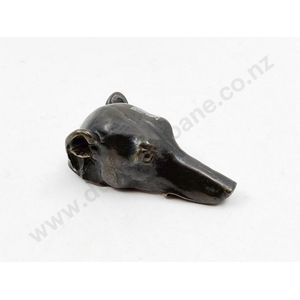Victorian Bronze Whippet Dog Head: 11cm Length Hollow Cast
Victorian bronze hollow cast whippet dog head, 11 cm length
You must be a subscriber, and be logged in to view price and dealer details.
Subscribe Now to view actual auction price for this item
When you subscribe, you have the option of setting the currency in which to display prices to $Au, $US, $NZ or Stg.
This item has been sold, and the description, image and price are for reference purposes only.
- Bronze - An alloy of copper and tin, traditionally in the proportions of about 9 parts of copper to 1 part of tin.
The discovery of bronze in Western Asia in the 4th century enabled people to create metal objects which were superior to those previoulsy possible because of its strength and hardness, and it has been used throughout the world for weapons, coins, tools, statuary and other decorative items.
It is very fluid in a molten state, and its hardness, strength when set, and non-corrosive properties makes it most suitable for casting sculpture. - Hollow Cast - Hollow casting is a metalworking process used to create hollow objects such as sculptures, jewelry, and other decorative objects. It involves casting metal in a mould that has a cavity in the shape of the desired object.
The process of hollow casting has been used for centuries, and its invention is not attributed to a single individual. However, ancient civilizations such as the Egyptians and Greeks used this process to create metal objects. In modern times, hollow casting has been used by artists, jewellers, and manufacturers to create a wide range of objects.
The first step in hollow casting is to create a model of the object to be cast from materials such as clay, wax, or metal, and from this a mould is created around it using a material such as plaster, silicone, or rubber. A core is created inside the mold to create the hollow cavity of the final object and then molten metal is poured into the mould, filling the space around the core. The metal is then allowed to cool and harden.
Once the metal has cooled and hardened, the core is removed from the mold, leaving a hollow object which is then finished by removing any excess metal or imperfections and polishing or texturing the surface as desired.
Hollow casting is used to create a wide variety of objects, including sculptures, jewellery, decorative objects, and parts for machinery. The process allows for the creation of complex shapes and details, and can be used with a wide range of metals, including bronze, brass, silver, and gold. Hollow casting is also used in manufacturing to create components such as engine blocks and machine parts. - Victorian Period - The Victorian period of furniture and decorative arts design covers the reign of Queen Victoria from 1837 to 1901. There was not one dominant style of furniture in the Victorian period. Designers used and modified many historical styles such as Gothic, Tudor, Elizabethan, English Rococo, Neoclassical and others, although use of some styles, such as English Rococo and Gothic tended to dominate the furniture manufacture of the period.
The Victorian period was preceded by the Regency and William IV periods, and followed by the Edwardian period, named for Edward VII (1841 ? 1910) who was King of the United Kingdom and the British Dominions and Emperor of India for the brief period from 1901 until his death in 1910.
This item has been included into following indexes:
